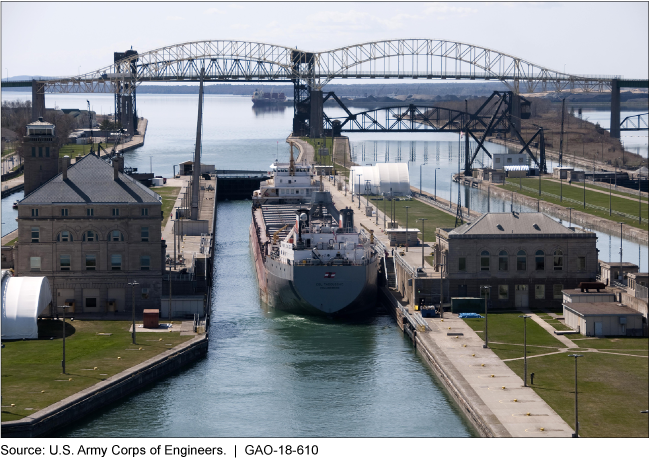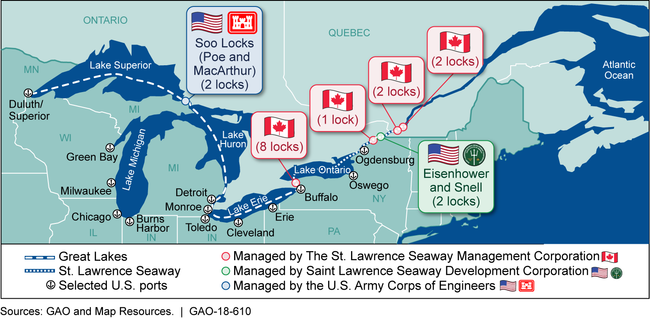Great Lakes-St. Lawrence Seaway: Assessing Risks and Measuring Performance Could Improve Maritime Transportation
Fast Facts
The Great Lakes-St. Lawrence Seaway has connected U.S. and Canadian ports to the world since 1959—but traffic has declined since 1980.
Stakeholders identified many challenges to using the seaway. For example, the cost of hiring pilots to navigate the system increased in 2016; older lock infrastructure is at risk of failure; and ports aren't set up to clear passengers and container cargo for travel.
We reviewed modernization efforts and found that U.S. agencies have completed almost $100 million in projects to improve locks over the past decade. We recommended better monitoring of the challenges and assessment of improvement efforts.
The Poe Lock in Sault Ste. Marie, Michigan—part of the Great Lakes-St. Lawrence Seaway

Photo of a commercial ship in a lock with a bridge in the background.
Highlights
What GAO Found
The tons of cargo moved by domestic Great Lakes and St. Lawrence Seaway traffic have declined since 1980—by 32 and 48 percent, respectively, according to U.S. Army Corps of Engineers (Army Corps) and Saint Lawrence Seaway Development Corporation (U.S. Seaway Corporation) data. Stakeholders identified various factors for this decrease such as the U.S. economy's shift away from manufacturing. Traffic on the Great Lakes-St. Lawrence Seaway (Great Lakes-Seaway) is traditionally dominated by bulk commodities like iron ore, although stakeholders noted emerging uses like containerized cargo and cruises.
The Great Lakes- St. Lawrence Seaway Navigation System

Stakeholders identified a range of challenges to using the Great Lakes- Seaway—such as inadequate portside infrastructure for intermodal transfers of shipping containers—that together pose risks for both traditional bulk cargos and emerging uses. Although the U.S. Seaway Corporation's mission is to improve the system's utilization and reliability, the Corporation has not fully assessed the risks that challenges pose to the system's users. Establishing a process to assess and monitor risks, in accordance with federal internal control standards, would help inform future actions to address identified and emerging challenges.
The U.S. Seaway Corporation and the Army Corps have made progress on lock asset renewal efforts, but the Army Corps lacks goals and measures to assess performance and outcomes of these efforts. According to estimates provided by the Army Corps, it has completed 18 projects totaling about $53 million to date, and has about $257 million in remaining and ongoing work through 2035. Meanwhile, the U.S. Seaway Corporation has completed 16 projects totaling $45 million and has almost $144 million in remaining and ongoing work through 2023. The Army Corps has not developed goals and measures to assess its asset renewal results, as the U.S. Seaway Corporation has done. As a result, the Army Corps lacks tools to assess the outcomes of these efforts and demonstrate the extent to which its asset renewal efforts have improved operational performance of the Soo Locks.
Why GAO Did This Study
The Great Lakes-Seaway system extends 2,300 miles and serves more than 100 ports in the United States and Canada. Four of the 17 locks that enable navigation are managed by the Army Corps (within the Department of Defense) and U.S. Seaway Corporation (within the Department of Transportation). The rest are managed by Canada. A 2007 U.S.-Canada study noted the system could absorb additional traffic and led to U.S. asset renewal plans to improve lock infrastructure condition.
GAO was asked to review efforts to modernize the Great Lakes-Seaway. This report examines (1) shipping trends since 1980 and factors affecting recent trends, (2) stakeholder views on challenges to use, and (3) the extent to which the Army Corps and the U.S. Seaway Corporation have made progress on and measure performance of lock renewal efforts. GAO analyzed Seaway and Army Corps shipping data from 1980 through 2016, the agencies' asset renewal plans, and interviewed 24 stakeholders, including port and shipper representatives, selected to represent a range of perspectives.
Recommendations
GAO recommends that (1) the U.S. Seaway Corporation establish a process to identify, analyze, and monitor risks to the system's use to inform future actions, and (2) the Army Corps develop and adopt goals and measures to assess the performance of the Soo Locks and assess of asset renewal outcomes. The Departments of Transportation and Defense concurred with our recommendations and provided technical comments which we incorporated as appropriate.
Recommendations for Executive Action
| Agency Affected | Recommendation | Status |
|---|---|---|
| Great Lakes St. Lawrence Seaway Development Corporation | The Administrator of the U.S. Seaway Corporation should establish a process to identify, analyze, and monitor risks to the system's use to inform future actions to address those risks. (Recommendation 1) |
The Great Lakes-St. Lawrence Seaway (Great Lakes-Seaway) system extends 2,300 miles from Duluth, Minnesota to the Atlantic Ocean and serves more than 100 ports in the United States and Canada. A series of 17 locks enables commercial vessels to navigate the system, with the majority under Canadian management. Two of the 17 locks-located in Massena, New York-are managed by the Department of Transportation's Great Lakes St. Lawrence Seaway Development Corporation (U.S. Seaway Corporation). The U.S. Seaway Corporation's stated mission is to improve the operation and maintenance of a safe, reliable, and efficient waterway and to improve regional economic and trade development by enhancing utilization of the entire Great Lakes Seaway system. In 2018, GAO reported that stakeholders GAO met with-including carriers, shippers, and port representatives-identified a range of challenges to using the Great Lakes-Seaway and noted that these challenges pose risks to the future use of the system. Specifically, stakeholders stated that the condition of lock and portside infrastructure and other challenges pose risks to the system's traditional uses-including the transport of bulk cargos such as iron ore, grain, and steel-and to emerging uses of the system-including the cruise industry and container market. GAO found that the cumulative effect of the challenges represents costs and system reliability risks to shippers that can erode the advantages that the system has traditionally offered over other transportation modes. Although U.S Seaway Corporation officials told GAO they are aware of system challenges cited by stakeholders, the Corporation has not fully assessed the extent to which the challenges pose risks to the use of the Great Lakes-Seaway. Officials from the U.S. Seaway Corporation told GAO that the Corporation has not fully assessed risks, in part, because the Corporation does not have a formal or standing process to monitor risks over time. As such, GAO concluded that without a formal assessment of risks, the U.S. Seaway Corporation lacks information on the cumulative effect of the challenges faced by users of the system, limiting its ability to inform its future actions to help address those challenges. GAO recommended that the U.S. Seaway Corporation establish a process to identify, analyze, and monitor risks to the system's use to inform future actions to address those risks. In March 2021, the Corporation established an internal risk management team and issued a risk management plan that was intended to provide a formal and consistent method to manage organizational and operational risks to help the corporation achieve its mission. The risk management plan established a process for the Corporation to (1) document and track risks that could affect its mission and operations; (2) prioritize risks based on their probable frequency of occurrence and severity of consequences; (3) develop appropriate mitigation measures to reduce the threats of specific risks; (4) monitor and identify risks on a quarterly basis through a risk management team comprised of senior management officials. By establishing this process to identify, analyze, and monitor the system's risks, the U.S. Seaway Corporation is better positioned to design future actions that it, and other stakeholders, could take to address those risks and improve efficiency and use of the system.
|
| Corps of Engineers | The Army Corps Director of Civil Works should, in coordination with the Commanders of the Great Lakes and Ohio River Division and the Detroit District, develop and adopt goals and measures to assess the performance of the Soo Locks and assess outcomes of asset renewal efforts. (Recommendation 2) |
In fiscal year 2007 the U.S. Army Corps of Engineers (Army Corps) developed an asset renewal plan focused on improving the condition of the Soo Locks, which connect Lake Superior to the remainder of the U.S. Great Lakes and which serve as an important route for the U.S. steelmaking industry. In 2018, GAO reported that although the Army Corps received $86 million to implement its asset renewal plan and had spent about $53 million on 18 completed projects, it had not established specific operational goals or metrics to evaluate the outcome of its asset renewal efforts, in accordance with government internal control standards. Federal internal control standards state that agencies should define objectives clearly and in measurable terms so that performance toward achieving those objectives can be assessed. Army Corps officials told GAO that they had not established operational goals or measures specific to the Soo Locks because the Army Corps' project approval process involves prioritization based on risk rather than operational performance. While this process allowed the Army Corps to prioritize individual investment decisions according to risk, it did not define a specific measurable goal for the operational performance of the Soo Locks. Without goals and measures for the Soo Locks, the Army Corps lacked a key tool to assess whether the investments made in the locks have resulted in improved lock performance, such as reductions in outages and delays to its users. Therefore, GAO recommended that the Army Corps develop and adopt goals and measures to assess the performance of the Soo Locks and assess outcomes of asset renewal efforts. In 2020, GAO confirmed that the Army Corps had established performance goals and measures for the Soo Locks. Specifically, in 2019 the Army Corps completed an operational condition assessment through which it established a baseline for the goals and metrics it will use to measure Soo Locks improvement impacts starting in March 2020. The Army Corps established two goals for the Soo Locks: (1) to have no more than 10 unscheduled outage hours per year, and (2) for 100 percent of critical lock components to have a 'B' condition assessment rating or better. As a result of developing and implementing these performance goals and measures, the Army Corps will be in a better position to demonstrate outcomes of its asset renewal projects, including whether those projects improve the condition of lock components and the operational performance of the Soo Locks by reducing unscheduled outages for users.
|
